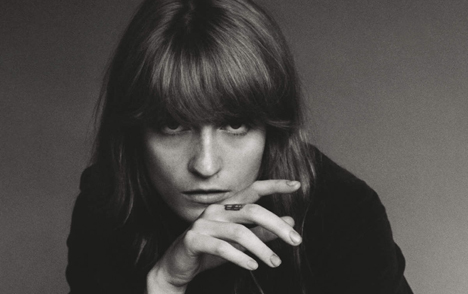Written by Jason Gottfried
Kate Bush is a British pianist, dancer, and singer-songwriter who is relatively unknown in the States—which is a pity, as she broke the ice on the musical pond that other female art-rockers have come to inhabit, none of whom have matched her in terms of her dramatic grandeur, her constant and dizzying originality, and that kaleidoscopic voice with no Earthly peer.
In Bush’s delicate footsteps have trodden the likes of Tori Amos, Sinéad O’Connor, Paula Cole, Fiona Apple, Cocteau Twins, and Bjork but in some ways, none so much as Florence Welch and her ever-present Machine.
In that spirit, “How Big, How Blue, How Beautiful” almost sounds like a mid-’80s album: there are no EDM tracks, banjos, or other meaningless (but now commonplace) frills. They’re unnecessary. There’s little to solidly ground the album in 2015 stylistically, and that’s a big compliment. Deciding which songs are going to be singles is a guessing game, and—best of all—there’s no good way to describe the soulful pop-rock sound other than “Florence + The Machine.”
Markus Dravs, an Emmy-winning producer who has worked with stadium acts like Mumford and Sons, Arcade Fire, and Coldplay, was well-suited to handle “How Big, How Blue, How Beautiful,” which feels a little more open than “Ceremonials,” as if Dravs has peeled back a layer or two, cleared out some cobwebs, or trimmed off an inch or so of rind.
Dravs allegedly forbade Welch from writing more songs about water. She didn’t seem to listen, as the album opens with “Ship to Wreck,” which sounds like so many bands—and yet, none of them in particular—with elements of Fleetwood Mac, Annie Lennox, and The Cranberries speaking most prominently. This is the first in a series of introspective songs wherein Welch questions her own behavior and is forced to confront the consequences directly.
“What Kind of Man” opens quietly but soon takes a ferocious turn, demanding “What kind of man loves like this?” amid trumpets, electric guitar, and a towering, overdubbed chorus of Welch’s own voice, which has the same demanding verve as Fiona Apple’s in “Criminal.”
As the sultry title track opens, it becomes apparent why Welch has so often been compared to Tori Amos and P. J. Harvey. However, the orchestral arrangement is far more immense than anything Harvey would deliver—although Amos might. It’s comparable to some of Bjork’s more expansive arrangements— “Isobel,” from “Post,” or “The Dull Flame of Desire,” from “Volta,” for example—with a lush and majestic orchestral arrangement provided by Will Gregory (of Brit-pop duo Goldfrapp) that swells to dizzying heights.
“Queen of Peace” begins as “How Big, How Blue, How Beautiful” ends: symphonically and with harmonic similarities between the two songs, “Queen of Peace” almost feels like a companion piece to its precedent, or a second movement. However, while the former leans toward funk or sass, the latter has a decidedly Motown, four-on-the-floor feel, as if someone had accidentally locked the London Philharmonic inside Studio 54.
Four fairly intense songs are followed by “Various Storms and Saints.” Welch sings with no less passion but is accompanied only by a tremolo-drenched guitar and light strings rather than a full band and 35-piece orchestra.
“Delilah” begins with the same snarl as “How Big, How Blue, How Beautiful,” and when it finally kicks into fifth gear, it kicks in hard. Welch’s signature frenetic, trembling vibrato is aquiline, soaring and slicing with equal ease. When she dubs it in octaves or unison, it creates the kind of ghostly chorus evocative of a haunted night in swampy Ireland. Like Kate Bush, she is at her best when creatively orchestrating her voice with itself.
More subdued is “Long and Lost,” in which Welch voices doubt and regret: “Is it too late to come on home? / Are all those bridges now old stone?” She continues this ambivalence in “Caught”: “Somewhere between / Desperate and divine / I can’t keep calm, I can’t keep still.”
Like the sun breaking through clouds, “Third Eye” is one of the album’s highlights. Dravs’ influence is clear, as this song is stadium-ready, with rolling drums and verses that are more proclaimed than sung. Welch’s third eye is “an original lifeline,” as she chants, “I’m the same, I’m the same / I’m trying to change.”
“St. Jude,” yet another song that stylistically eludes era-specificity, is a mournful paean to the “patron saint of lost causes” set to woodwinds and organ, with light electronic percussion in the background.
The album ends strongly with “Mother,” co-produced by studio legend Paul Epworth, which recalls the swagger and strut of the title track. As such, this final song is a statement of renewal and redemption, a wiping away of tears. While Tori Amos’s song, “Mother,” is about loss of innocence and vulnerability, and while Kate Bush’s “Mother Stands for Comfort” reads on so many levels, Welch’s “Mother” is an act of surrender to a higher power and a subsequent gathering of strength:
“Mother, make me
Make me a big tall tree
So I can shed my leaves and let it blow through me
Mother, make me
Make me a big grey cloud
So I can rain on you things I can’t say out loud.”
At only 28 years old and three albums deep into what has been from the start of a world-changing musical career, Welch already stands head and shoulders above her peers. At 28, Bjork had just released “Debut,” which redefined electronic music in the pop world. A 28-year-old Tori Amos was wrapping up “Little Earthquakes,” which would put her on the musical map, and Kate Bush herself had just released “The Hounds of Love” and was working on “The Sensual World,” easily her two strongest albums. Similarly, with the confident release of “How Big, How Blue, How Beautiful,” Welch is at the top of her game, continuing to establish her legacy as one of the great female singer-songwriter-producers of our time.




